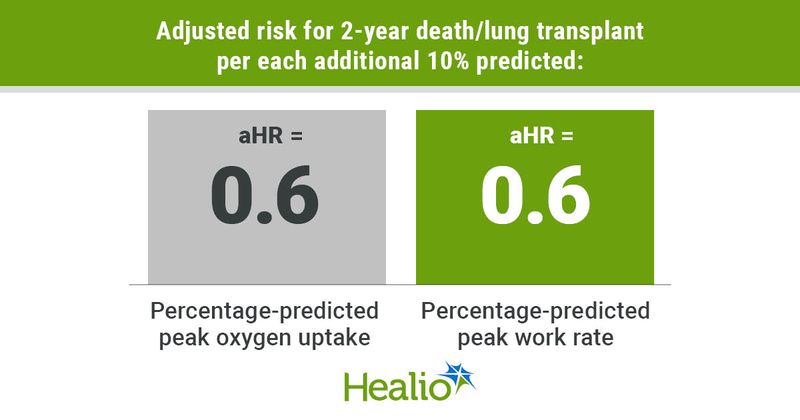Peak work rate, oxygen uptake predictors of death/lung transplant in advanced CF
Key takeaways:
- Peak work rate and peak oxygen uptake are measured during cardiopulmonary exercise testing.
- More patients with a lower vs. higher peak work rate died or underwent lung transplantation.
Among patients with advanced cystic fibrosis lung disease, two cardiopulmonary exercise testing outcomes could predict death/lung transplantation, according to results published in Annals of the American Thoracic Society.
“[Peak work rate] provides similar prognostic information to [peak oxygen uptake] regarding 2-year risk of death/lung transplant and can be easily measured in almost all settings,” Thomas Radtke, PhD, senior researcher at University of Zürich’s Epidemiology, Biostatistics and Prevention Institute, and colleagues wrote.

In an international, multicenter study, Radtke and colleagues assessed 174 patients with advanced cystic fibrosis lung disease (FEV1 ≤ 40% predicted) and data from a cycle ergometer cardiopulmonary exercise test between January 2008 and December 2017 to find out if this type of testing offers prognostic information on 2-year mortality/lung transplantation risk.
As Healio previously reported, cardiopulmonary exercise testing was the recommended “gold standard” test for patients with CF in a multidisciplinary expert consensus document published in European Respiratory Reviews.
The mean FEV1 of the study population was 30.9% predicted.
Within the full cohort, 33 patients had a lung transplant, and 11 patients died, totaling 44 patients (mean age, 30.5 years; 47.7% female). The remaining 130 patients (mean age, 29.8 years; 39.2% female) made up the survivor cohort.
Some notable differences between the death/lung transplant group and survivor group included mean FEV1 (27.3% predicted vs. 32.1% predicted), P. aeruginosa prevalence (95.5% vs. 67.7%), CF-related diabetes prevalence (52.3% vs. 44.6%) and mean exercise duration (318 seconds vs. 392 seconds).
Following adjustment for age, sex and FEV1, researchers found two significant predictors of death/lung transplantation on cardiopulmonary exercise testing: percentage-predicted peak oxygen uptake (adjusted HR = 0.6 per each additional 10% predicted; 95% CI, 0.43-0.9) and peak work rate (aHR = 0.6 per each additional 10% predicted; 95% CI, 0.48-0.82).
During an evaluation of 11 prognostic factors for survival, there was a strong relationship between peak work rate and 2-year mortality/lung transplant risk.
Researchers divided the total cohort based on the peak work rate cutoff value they found during receiver operating characteristic curve analysis and observed that patients with a peak work rate of 49.2% predicted or less had a significantly greater proportion of patients who died/underwent lung transplantation compared with patients with a rate greater than 49.2% predicted (45.2% vs. 10.9%).
“Our data highlight the potential for [peak work rate] to be a promising marker for [lung transplant] referral and candidate selection,” Radtke and colleagues wrote.
